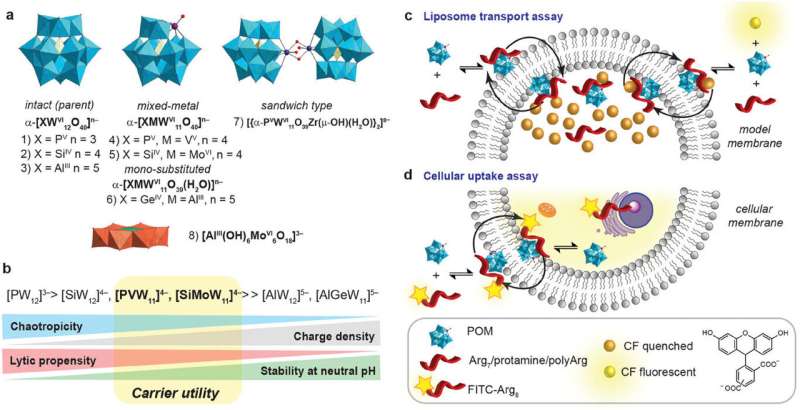Polyoxometalates show promise as drug transporters into the cell

A research team from the University of Vienna, in collaboration with the Constructor University in Bremen, showed that polyoxometalates (POMs) can transport biologically relevant cargo through biological membranes. The study was recently in Advanced Materials . It will help position POMs as components of next-generation medicines, revolutionizing the field of drug delivery.
The therapeutic effectiveness of a drug depends on whether it reaches the target cells in the body and causes no or minimal side effects. A particular challenge for many potential drugs—especially for water-soluble bioactive molecules—is the passage through biological membranes in order to subsequently achieve the specific targets of the therapeutic agent in the cells themselves.
The fact that a class of substances such as POMs, in addition to their already known potential in combating tumors, bacteria and viruses, can also act as "drug transporters" is a new discovery—and offers a promising solution to this long-standing challenge of overcoming membranes.
Successful passage
Polyoxometalates are a special chemical group of substances: They consist of oxygen-containing anions that contain several metal ions. These POMs are known for their extraordinary chemical property of super-chaotropy—the inherent tendency of large charge-delocalized anions to interact with hydrophobic matter.
Annette Rompel from the Institute of Biophysical Chemistry at the Faculty of Chemistry explains. "In our experiments, we were able to show both on model membranes and on living cells that certain mixed-metal POMs can be effective transporters for various active ingredients. POMs have a sufficient stability and can transport impermeable, hydrophilic and cationic peptides (proteins) through the membranes."
This overcoming of the membrane hurdle is critical to improving treatment precision and efficiency through improved cellular uptake—resulting in fewer side effects and better outcomes for patients.
Promising prospects
Nadiia Gumerova, a lead author of the study and senior inorganic scientist at the Institute for Biophysical Chemistry at the University of Vienna, is convinced of the possibilities that POMs offer as transport molecules. "POMs are a promising class of substances in medicine due to their enormous structural diversity. With our further investigations, we will be able to break new ground in drug delivery and open up new horizons in the pharmaceutical industry."
This new technology is already causing a stir in the scientific community—and the research team at the University of Vienna will continue to make every effort to push the boundaries of what is possible in drug research.
More information: Andrea Barba‐Bon et al, All‐Inorganic Polyoxometalates Act as Superchaotropic Membrane Carriers, Advanced Materials (2023).
Journal information: Advanced Materials
Provided by University of Vienna




















